When it comes to guitar players, the British vs American guitar amplifiers debate has persisted for years. Understanding their differences is key to achieving your desired sound! In this article, I’ll reveal everything you need to know to put you on the right path to getting the guitar amp that works with your musical style and playing technique.
You can use the table of contents below to take you to the area that interests you. Click on the little box to open it, and then click on the section of the article you want to read, or you can read from start to finish if you want the full amplifier experience!
The Short Answer
British guitar amplifiers give a warm tone that breaks up at a lower volume with gain that has a loose “crunch” and a distinctive “growl.” American amps have a clean, bright tone that retains clarity at a high volume with a tight, focused, percussive gain sound. The British sound is ideally suited for Rock, Metal, and Punk, while the American sound is better for Blues, Country, and Jazz.
Keep On Reading (Below) To Learn More
British Vs. American Amplifier Comparison

This table will give you all the essential differences between British and American amps. Note that there can be exceptions among various amplifiers.
| Comparison | British Amplifiers | American Amplifiers |
|---|---|---|
| Characteristic Tone | Aggressive, punchy, and warm | Clear, articulate, and bright |
| Power Tubes Commonly Used | EL84, EL34 | 6V6, 6L6 |
| Clean Tone | Warm, breaks up at a lower volume | Clean, bright, retains clarity at high volume |
| Gain Tone | Gain has a looser “crunch,” and a distinctive “growl” | High gain is tight, focused, percussive |
| Headroom | Typically less | Typically more |
| Best For | Rock, Blues, Punk, Metal | Jazz, Country, Blues, Rock, Metal |

Key British Amplifier Characteristics
I love the warmth and break-up of British amps when pushed into overdrive or distortion! It took me a while to get a Marshall back in the early ’70s because they were hard to come by in the U.S.A.
They’re perfect for achieving that classic rock and blues crunch. They also have an aggressive and punchy gain tone. This could be a huge plus if you’re into rock, punk, or heavy metal.
Amps like Marshall, Orange, and Vox have a unique tonal character that’s become synonymous with British rock music. Their distinct crunch and break-up give them a personality that’s hard to replicate.
Thanks to the use of EL84 and EL34 tubes, British amplifiers often provide harmonic richness and complexity to the tone, particularly when overdriven, which many guitarists find desirable.
The low-end response on British amps can be looser compared to American amps. For some styles, this can result in a less defined sound.
British amps typically have less headroom than American amps, which means they can start to distort relatively early, which might not suit all playing styles. This is often seen as a benefit among Rock and Metal players, while clean players like Jazz guitarists prefer the cleaner sound of American amps.
Unique Features
Vox amps, like the iconic AC30, often include a ‘Top Boost’ feature, which adds extra gain and EQ controls for the normal channel, perfect for rock and pop sounds.
Marshall amps are renowned for their simplicity. The vintage-style amps usually typically have one channel and minimal controls. This simplicity leads to a pure, raw tone that’s become the backbone of rock ‘n’ roll. The legendary ‘Plexi’ sound, characterized by its aggressive crunch and superb dynamics, is a prime example.
Orange amps are known for their high-gain and fuzzy tones, often with enhanced lower frequencies that can create a heavier sound. This feature has made Orange a favorite among some Rock and Metal players.
Key American Amplifier Characteristics
On the other hand, the sound of American amps is close to my heart because it’s the sound I grew up with as a beginning guitar player.
I was a “Fender guy” through and through, but I knew I could get a distorted or heavier sound with humbucking pickups and a distortion pedal. My go-to rig was a stock Stratocaster with a Band Master amp and an Electro Harmonix Big Muff Pi.
American amps, like those made by Fender, are celebrated for their tight, focused low-end response and crystal clear, clean tones.
Moreover, these amps traditionally use 6V6 and 6L6 power tubes that create a bright chime with a smooth tone.
They typically retain clarity and richness even when the volume is cranked and a strong mid-range, thanks to their extra headroom. This provides a full-bodied and robust tone that cuts through the mix well, making them ideal for genres like Country, Blues, and Jazz.
They generally don’t break up as early as British amps. These might not be the best fit if you’re seeking a crunchy tone at lower volumes. On the other hand, if you like the sound of American amps, you can always use an overdrive or distortion pedal.
Compared to their British counterparts, American amplifiers may offer less harmonic saturation, which means they might not deliver the rich overdriven tones that some guitarists seek.
Unique Features
For example, the built-in spring reverb of a Fender Deluxe Reverb is considered one of the best around, adding a lush, spacious quality to the tone that’s become synonymous with Surf Rock. Similarly, the tremolo or ‘vibrato’ effect found on many Fender amps provides a smooth, pulsating modulation that Blues and Rock players love.
On the other hand, high-gain American amps like Mesa Boogie tend to have multiple channels and extensive EQ options, offering a wide tonal palette and plenty of flexibility for various genres, from Blues to Heavy Metal.
Keep On Reading (Below) To Learn More
The Modern Era: Blurring The Lines
These days, many British and American amplifier manufacturers have started to blur the lines, incorporating features from both sides of the Atlantic. For instance, you’ll find British-style amps with lush spring reverb or American-style amps with EL84 tubes.
These features are particularly apparent on some boutique guitar amps, like certain Paul Reed Smith (PRS) and Friedman models. You can expect to pay more, but it may allow you to really dial in your sound.
This fusion allows for a broader range of sounds and gives guitarists more flexibility in sculpting their ideal tone.
Choosing Your Amp
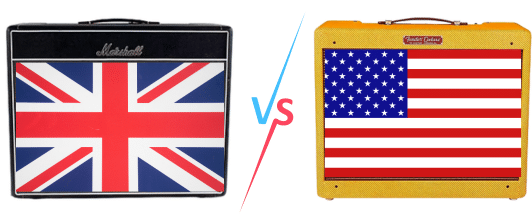
In high school, way back in the1960s, I had a Fender Stratocaster and Bandmaster amp. I loved the crisp cutting sound of my rig, but the more I got into playing Metal, the more I wanted a Marshall Stack.
When I was in college, I finally found a Marshall at a local American music store, but it was already sold! It took me a few more months to locate a Super Lead half-stack in New York. I kept the Strat and both amps. Eventually, I added Les Paul so I could cover any musical genre.
Choosing between a British or American amp all boils down to your preference and the sound you’re trying to achieve. Are you after that quintessential British rock crunch or the sparkling American clean tone? Do you need the tight, percussive distortion of an American high-gain amp, or do you crave the raunchy growl of a cranked British stack?
There’s no definitive answer to the question, is a British or American amplifier better? These amplifiers simply offer different tonal palettes for various musicians, musical genres, and budgets. Understanding these tonal differences can guide you in choosing the right amplifier for your sound.
Remember, using your ears is the best way to decide what’s best for you. Try them out, play around with the settings, and listen carefully. It’s your sound, after all.
Great British Amplifiers
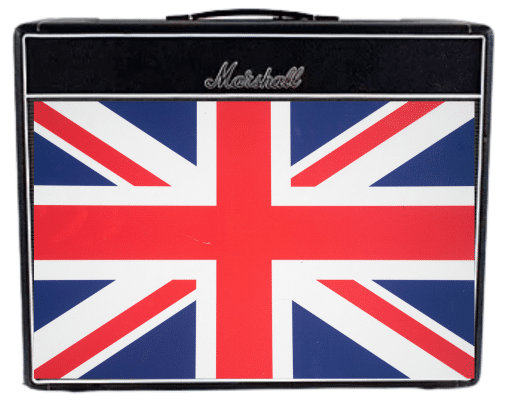
Many British amps like the Marshall Plexi or the Vox AC30 have reached iconic status. Their tones have been heard on countless classic records, making them a sought-after choice for those looking to recreate those legendary sounds.
- Marshall JCM800 – One of Marshall’s most famous amps, the JCM800 defined the sound of ’80s rock and metal.
- Vox AC30 – This amp has been an integral part of the British Invasion sound, used by bands like The Beatles and The Rolling Stones.
- Orange OR120 – Known for its high gain and thick tone, the OR120 is a favorite of thrash and doom metal guitarists.
- Hiwatt Custom 100 (DR103) – Hiwatt’s DR103 is famous for its clean headroom and has been used by artists like Pete Townshend of The Who and David Gilmour of Pink Floyd.
- Laney Supergroup 100 – Used by Tony Iommi of Black Sabbath, the Supergroup 100 helped shape the sound of heavy metal.
- Blackstar Series One 200 – Blackstar amps have quickly become a staple of the British amp landscape, and the Series One 200 is known for its versatility and high gain.
Each of these amps carries the legacy of British tone, yet they all have their unique character that has shaped various genres of music over the years.
Great American Amplifiers
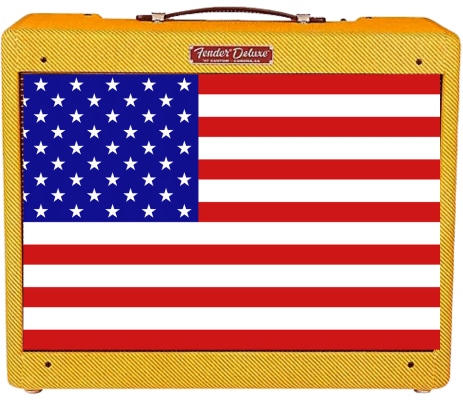
American amps such as the Fender and Supro have powered County and Jazz and helped kickstart Surf music and Rock and Roll. Bands like The Beach Boys and Ted Nugent are shining examples!
- Fender Deluxe Reverb – One of Fender’s most iconic amps, loved for its warm and clean tones used widely in Blues, Country, and Rock music.
- Mesa/Boogie Dual Rectifier – Known for its high-gain sound, the Dual Rectifier is a staple in Hard rock and Metal.
- Supro Thunderbolt – A vintage classic, the Thunderbolt is beloved for its unique, gritty blues tone.
- Bogner Ecstasy – A modern high-gain classic, the Ecstasy is known for its versatile and detailed sound.
- Dumble Overdrive Special – These boutique amps are known for their dynamic and sensitive response. Each Dumble is unique, hand-built to the specifications of the individual guitarist.
- Matchless DC-30 – A cornerstone of the ’90s boutique amp movement, the DC-30 is loved for its chimey, Vox-like clean channel, and responsive overdrive.
Each of these amps has a unique place in American music history, defining various genres and playing styles throughout the decades.
Cost Considerations
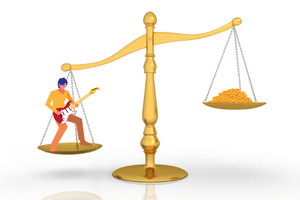
The cost can be a concern when you buy a guitar amplifier, even for pro players. The best amp for you isn’t necessarily the most expensive one.
You don’t have to spend a lot of money to get a great amp! Depending on your needs, you might be better off buying a cheaper British and American amp and getting two for the price of buying one that is considerably more expensive.
The other way to go is to get a modeling amp that has convincing British and American simulations.
British Amplifiers
The cost of British amps can also vary significantly. High-end brands like Marshall, Orange, and Vox offer premium models that can be quite pricey. These amps are often hand-wired and feature superior components, plus they come with the prestige of owning an amp that’s been part of music history.
However, these manufacturers also offer more budget-friendly options. The Marshall MG, Vox Valvetronix, and Orange Crush series are examples of more affordable models that still aim to capture the classic British tone.
The price you pay can often determine the quality and tonal versatility you get. Your budget should certainly be a significant factor in your decision, but it’s also crucial to consider the amp’s sound, build quality, and features.
American Amplifiers
As with British amps, American-made amplifiers can range broadly in price. For instance, high-end brands such as Mesa/Boogie or certain Fender models can be expensive due to their superior build quality, proprietary technology, and iconic status. These amps often use premium components and offer extensive tonal versatility, which also contributes to the price tag.
However, there are also plenty of more affordable options. Fender, for instance, has a wide range of budget-friendly models in their catalog, such as the Champion series, that still offer good quality. Additionally, manufacturers like Peavey offer reliable American-style amps at a lower cost, making them a popular choice for beginners and those on a budget.
Tube (Valve) Vs. Solid-State Amps
Another cost-related factor to consider for both American and British amps is maintenance. Tube amplifiers require periodic tube replacement, and depending on the type of tubes used (6V6, 6L6, EL84, EL34, etc.), the cost can vary.
Modeling Amps Can Give You The Best Of Both Worlds!
Modeling amps are yet another option. They offer digital simulations of iconic British and American amplifiers. The cost can vary based on the brand name, power output, number of amp simulations and effects, and how realistic-sounding the simulations are.
Modeling amps with high-definition, organic-sounding simulations are more expensive, but you can buy a decent-sounding amplifier without breaking the bank!
Used Amplifiers Can Be A great Option!
Finally, remember that the used market can be an excellent place to find great deals on American and British amplifiers. Many musicians have found their dream amp for a fraction of the cost by shopping for used items. Just be sure to check the condition and function of the amp carefully before making a purchase!
Don’t Buy An Amp For Its Name Or Reputation!

Don’t buy a guitar amplifier based on hearing someone else play through it or because it looks cool. So many factors can influence the sound of an amplifier, like playing style, the guitar and effects pedals used, and the playing environment (recording studio, live gig, etc.).
If you like the sound of an amp, it’s best to play through it with your guitar to hear how it works with your particular technique and skill level.
Even iconic Marshall and Fender amps may not be your best choice. For example, a Marshall Plexi sounds and plays totally different than a Marshall JCM 800, and you can’t compare a vintage Fender Bassman to a Fender Quad Reverb!
If you buy an amplifier online, don’t assume it is returnable without a restocking fee and that the store will pay for the return shipping!
Frequently Asked Questions

Here are some of the questions I get asked about British vs American amplifiers.
If your question does not appear here, please put it in the comments, and I will get right back to you with an answer.
Why Are British Amplifiers Often More Expensive?
This may be due to several factors, including brand prestige, import costs, build quality, or the use of premium components.
Which Is Better, A Tube Amplifier Or A Solid-State Amplifier?
Both have their benefits. Tube amps are known for their warm, dynamic tone, while solid-state amps are more reliable and require less maintenance.
Are British And American Amplifiers Built Differently?
Yes, they often have different circuit designs, use different types of tubes (like EL34 and EL84 for British, 6V6 and 6L6 for American), and even the speakers can be different.
Are there Hybrid Amps That Can Do Both British and American Tones?
Yes, several manufacturers produce versatile amplifiers that offer a range of British and American tones, such as Mesa Boogie.
Are British Or American Amps More suitable For A Beginner?
Both British and American companies offer beginner-friendly amplifiers. The choice depends on personal preferences, budget, and the desired sound.
Are British Amps Louder Than American Amps?
No, not necessarily. Loudness depends on wattage, speaker efficiency, and how the amp is designed and built, not the country of origin.
Final Thoughts

I hope you found this article on British vs American guitar amplifiers helpful.
British guitar amplifiers give a warm tone that breaks up at a lower volume with gain that has a loose “crunch” and a distinctive “growl.” These amps are ideally suited for Rock, Metal, and Punk
American amps have a clean, bright tone that retains clarity at a high volume with a tight, focused, percussive gain sound. They are typically better for Blues, Country, and Jazz.
By understanding their characteristics, you can make a more informed decision when choosing an amplifier that best suits your needs and musical style.
However, the most crucial factor to consider is how an amp inspires you to play. If you love how you sound, you’ll love how you play, and that’s what really matters.
So, plug in, turn up, and let your ears be the judge. The perfect amplifier for you is the one that brings your music to life.

Here’s a great video from Sweetwater Music that I know you’ll like on the difference between tube vs. solid-state amps! Check it out!
What To Read Next ➡ Why Do Guitar Amps Have 2 Channels? – Are 2 Better Than 1?
Related Article ➡ Choosing The Right Amp For Your Style Of Play: Pro Secrets!
Tell Me What You Think

Please leave a comment below if you enjoyed this article, have any questions about British or American amplifiers, or want to give your point of view. I will be happy to help you.
- Do you prefer British or American guitar amplifiers? Why?
- What kind of amp do you use? Why do you like it?
- What type of amplifier does your favorite guitar player use?
- After reading this article, are you thinking of changing guitar amps? Why?
- What else is on your mind?

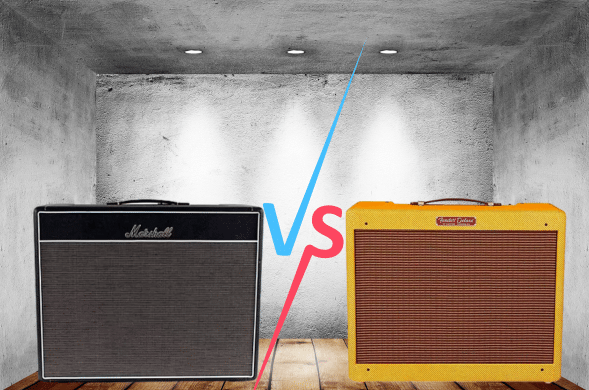

Thank You Frank for your very detailed and inclusive review of the differences between British & American Guitar Amplifiers!
I didn’t realize that the British sound is ideally suited for Rock, Metal, and Punk, while the American sound is better for Blues, Country, and Jazz.
Very interesting indeed!
It’s awesome that the American & British manufacturers of amplifiers are now creating more features of both, especially the Paul Reed Smith (PRS) and Friedman models.
Also, Thank You for sharing the great video from Sweetwater Music, it was Awesome!
Tony
Hi, Tony
I appreciate your comments!
American and British guitar amps both have excellent uses in various musical styles. The only limitation is our imagination.
Rock On! 🤘
Frank 🎸
Thank you for this comprehensive article comparing British and American guitar amplifiers, Frank. It’s evident that you have a deep understanding of the topic and have provided valuable insights for guitar players looking to achieve their desired sound.
The way you describe the characteristic tones of British and American amplifiers is spot on. The warm, aggressive, and punchy tone of British amps that breaks up at lower volumes is indeed well-suited for genres like rock, metal, and punk. On the other hand, the clean, bright, and articulate tone of American amps, with their tight and focused gain sound, is ideal for blues, country, and jazz.
Hi, Anoth
Thank You for your comments!
I’m glad you enjoyed the article!
Please let me know if you have any questions.
Rock On! 🤘
Frank 🎸